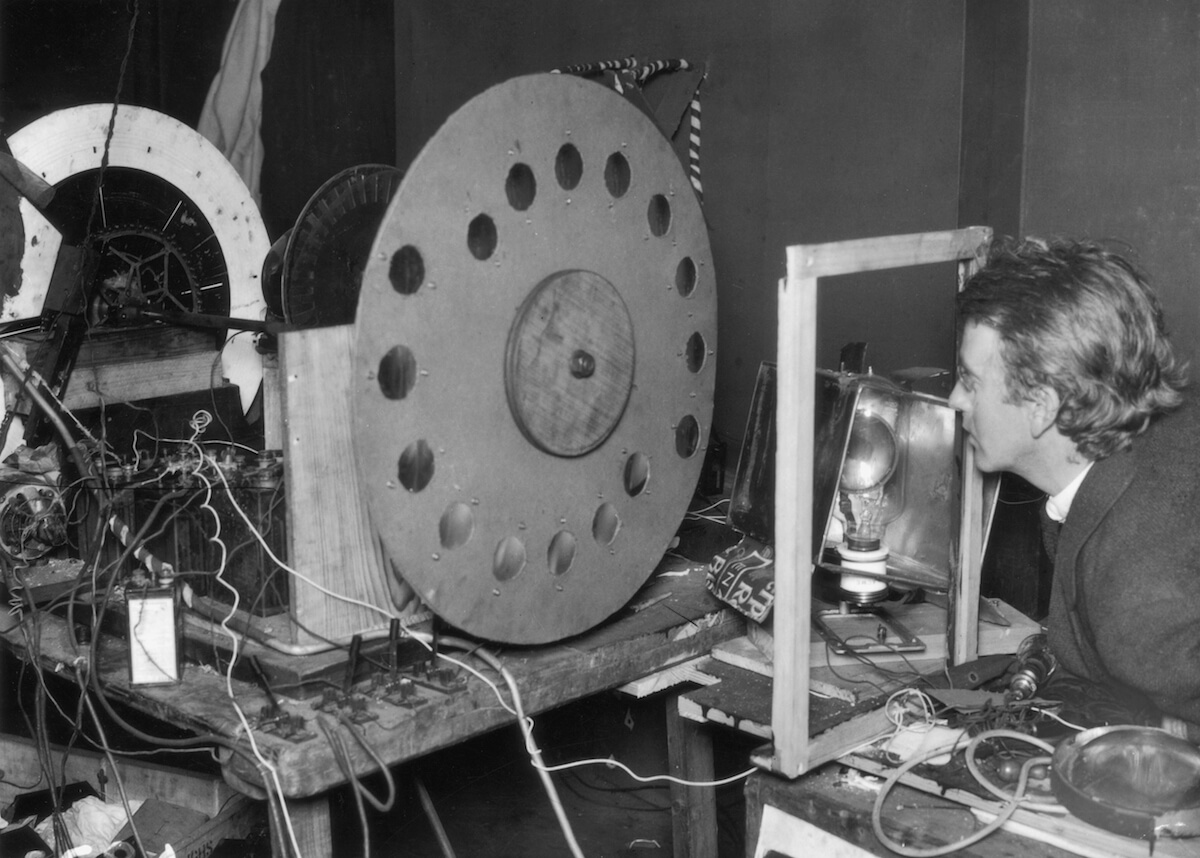H&M is selling Flintstones T-shirts like there’s no tomorrow but do most people know this is truly an almost pre-historical TV series?
This show is so old, it was available almost on the very first TV sets – but not quite!
In this story we’ll offer some fascinating answers to the question of “when did TVs come out?” because, as with most world-changing inventions, the history of television is full of fun stuff. Love vintage tech? Scroll on!
When did TVs come out?
The correct question to ask is “What did the first TV look like?” because TVs as a concept had been around for decades but the actual gadget that’s still the center of most people’s homes was launched in about 1929 – almost a full century ago!
The first television system was created by John Logie Baird, a Scottish engineer.
John Logie Baird stands next to his television transmitter of 1925–26. To Baird’s left in the case is “Stookie Bill,” a ventriloquist’s dummy that was scanned by the spinning Nipkow disk in order to produce a picture signal. Image courtesy of Malcolm Baird, posted by Britannica.
His mechanical television used a spinning “Nipkow disk,” a mechanical device to capture images and convert them to electrical signals. When sent by radio waves, these signals were picked up by a receiving device, whose own disks would spin similarly to create a replica of the original images.
If you want to do a bit of engineering and need inspiration, here’s someone using a Nipkow disk with Arduino.
“It is a given that a Hackaday reader is unlikely to stumble upon a Baird Televisor or other mechanical TV set. But the beauty of this technology is that a Nipkow disk is straightforward to make. The elementary school method involves marking a piece of card or similar flat material at the appropriate angles for the position of the holes and then measuring their position from the centre at each angle with a ruler, but a contemporary suggestion was to draw a spiral with the aid of a piece of piano wire wrapped round a central shaft. Alternatively Hackaday readers may wish to try creating a pattern for one programatically, this is the solution I opted for back when I was experimenting with Nipkow disks,” writes Hackaday in this fascinating article.
John Baird was an incredible mad scientist, in short.
“Baird, the inventor of the mechanical TV, was a Scotsman with an entrepreneurial spark. He was constantly trying out crazy ideas, like a rustless glass razor and inflatable shoes. He was nuts in the best possible way,” writes Vox in their story on mechanical television.
However, while Baird might have invented TV in the absolute sense, many new technologies had to appear in order to combine into what we know and watch today.
It was actually in Japan where the first cathode ray tube TV was invented.
In 1926, Kenjiro Takayanagi from the Hamamatsu Industrial High School in Japan demonstrated the first working example of a fully electronic television receiver – unlike the Baird system, which was mechanical.
The history of television is a complicated one and many inventors lay claim to inventing the TV.
“Philo Taylor Farnsworth successfully demonstrated the first television signal transmission on September 7, 1927 with his own scanning tube. A legal battle ensued in the late thirties, when RCA, the company Zworykin worked for wanted to claim the right to the patent (and the royalties). The court however ruled in favor of Farnsworth, giving him patent priority and making him, officially the inventor of the first fully functional, all-electronic television,” writes History of the Net.
In this series we’ll discuss the evolution of television by taking a look at the various types of TVs through the years, from antique television sets all the way to the invention of 4K TVs. In part 2, we’ll also look at the history of TVs through the lens of programming, seeing the most beloved TV shows of all time and when they first appeared.
What was the first TV show ever?
As we explain in part 2 of this overview on the history of television, even though TV sets had displays the size of a postage stamp or a deck of cards, programming was still a thing.
The very first full-length program broadcast in the US was a drama in one act called The Queen’s Messenger by J. Harley Manners, aired by The WGY radio station on September 11, 1928. Want to watch the first TV show in history? Youtube has a bit of it. Oh, to find the full 40 minutes of The Queen’s Messenger, what an incredible watch that would be!
Still, if you want to find out more about the history of TVs and which vintage TVs changed the world, let’s see the big picture first.
Think of the 90s and you probably remember plasma TVs being all the rage.
When did plasma TVs come out?
Pretty late, actually – at the end of the 90s.
The first full-color plasma display was produced by Fujitsu in 1992 and it totally changed the world. In a nutshell, this was basically every scifi fantasy ever put to paper or small screen – a sleek device with a huge screen and so sleek it could be hung like a painting on the wall.
“Fujitsu’s flat-screen plasma television, introduced in 1997, was literally a promise out of science fiction. At about 3 inches thick (75 millimeters), it was as thin as anyone then could hope for. It weighed a trifling 40 pounds (18 kilograms). With a screen that measured 42 inches diagonally, it was about as big as a TV could be in those days.
In short, it was the first large, flat TV that could be mounted to a wall. And to understand why this was such a big deal, you need to go back to “Star Trek.” Not the endless movies and sequels but the original TV series. If you are old enough to have watched “Star Trek” in 1966, more likely than not it was on a black-and-white set with a screen measuring no more than 21 inches diagonally. All TVs at the time—B&W or color, and regardless of the size—were built around a heavy cathode-ray tube (CRT) mounted inside a massive cabinet that was sturdy by necessity. CRT TVs weren’t just displays, they were furniture. That’s why of all the amazing technologies on “Star Trek”—tricorders, warp drives, doors that shooshed open—none announced that “THIS IS THE FUTURE” more than the view screen on the bridge of the USS Enterprise. It was huge. Even more futuristic, it was flat—and mounted to the bulkhead!,” explains IEESpectrum.
However, by the time you could buy a plasma TV it was already 1997 and you’d have had to have a serious bank account to pull it off.
The first plasma TVs to be sold directly to consumers were made by Philips in 1997. The first plasma TVs had a 42-inch display and about $15,000 on their price tag. It was a painful price, made even moreso by the fact that a plasma TV had issues with phosphor burn-ins, which could ruin the display, and drew a lot of power.
The difference between plasma and LCD TVs is one based on the underlying tech. While both TVs look similar, Plasma TVs are based on fluorescent light bulbs. Their displays are basically clusters of cells surrounded by gas.
“Within each cell, a narrow gap that contains an insulating layer, address electrode, and display electrode, separates two glass panels. In this process, neon-xenon gas is injected and sealed in plasma form during the manufacturing process.
When a Plasma TV is in use, the gas is electrically charged at specific intervals. The charged gas then strikes red, green, and blue phosphors, creating an image on the screen.
Each group of red, green, and blue phosphors is called a pixel (picture element — the individual red, green, and blue phosphors are called sub-pixels). Since Plasma TV pixels generate their light, they are referred to as “emissive” displays,” explains Lifewire.
Unlike plasma TVs, LCD TVs use a backlight. When that backlight is turned on, it applies a voltage to the pixels, which then rotate certain ways to allow light to pass through and produce an image.
The simpler explanation of the difference between plasma and LCD TV is that a plasma TV generates light, while LCD filters light in order to show you an image. Even though the technology is mostly phased out, plasma TV also looked a lot better in every angle, whereas LCDs have certain viewing angles, where you can see less details if you look at the screen from the side.
Plasma TVs also offered better contrast, with deeper blacks and brighter whites, as well as better motion handling, which made them great TVs for gamers. Still, the last plasma TVs were manufactured around 2015 and LCDs have really come a long way since.
When did flat screen TVs come out?
The history of television is a complicated matter but you’ll be surprised to know that flat screen TVs didn’t come out in the 90s alongside plasma.
Their history goes even further back than that!
University of Illinois professors Donald Bitzer and Gene Slottow, assisted by graduate student Robert Wilson, demonstrated the first flat TV in July 1964. Their TV showed a single color but used a similar technology to plasma TVs – inert gas sealed between glass plates.
It was more than a decade later, in 1977, when JP Mitchell demonstrated the first LED flat panel TV, although images of it are almost impossible to find nowadays.
Still, flat screen TVs became a reality for everyone in the late 90s.
When did OLED TVs come out?
Just as people were finding it affordable to actually buy a plasma TV, since the price was no longer $15,000, Sony introduced the OLED TV. The first Sony OLED TV came out in 2004 and was based on a technology invented in the late 80s.
“OLED has been in the industry since 1987. It was invented by chemists Ching Tang and Steven Van Slyke from Kodak. Even though it has been invented for a while, mass production of OLED did not start till recently,” explains Orient Display.
Why?
Because, just like plasma TVs, OLED TVs were expensive to make and their lifespan was very short. It was only in about 2010 when OLED TVs became affordable and widespread.
What are the advantages of OLED TVs over LED and LCD? The same as what plasma TVs had over LCD TVs. OLED TV’s have self-lighting pixels and no backlight to form the picture, which offers better viewing angles and a faster refresh rate.
When did smart TVs come out?
Once again, this is a matter of debate, though you can basically thank the French for it.
Fast France Advance Systems, a French company, received the first patent for a smart TV back in 1994. A majority of adults weren’t even online by then but the company envisioned a television connected to it.
Still, the history of television goes a lot further back than 1994 and it was actually almost a century ago where the true magic happened.
Let’s do a breakdown of vintage TVs through each decade and see for yourself the technology that changed the world.
The video above is a great look at the evolution of TVs but take a look at the images we compiled as well – lots of cool vintage TVs to see!
Check out the evolution of TVs through the decades here.
Follow TechTheLead on Google News to get the news first.

















